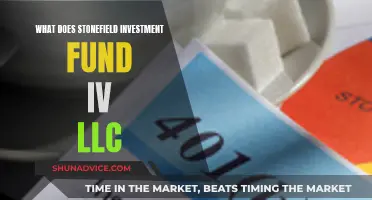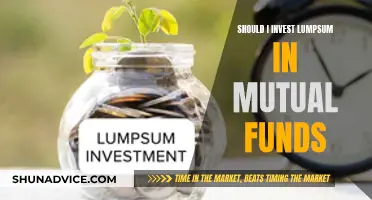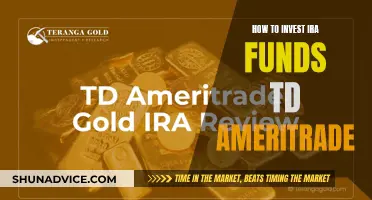
Exchange-traded funds (ETFs) and mutual funds are both popular ways for investors to diversify their portfolios. While they share some similarities, there are also some key differences between the two. This article will explore the pros and cons of each, covering topics such as investment minimums, management styles, tax implications, and more, to help you decide which option is right for your investment goals and strategy.
What You'll Learn

Mutual funds vs ETFs
Mutual funds and exchange-traded funds (ETFs) are both professionally managed collections of stocks or bonds. They both offer instant diversification at a low cost and are considered safer than investing in individual stocks and bonds. However, there are some key differences between the two.
Similarities
Mutual funds and ETFs are similar in that they both represent professionally managed collections (or "baskets") of individual stocks or bonds. They are both less risky than investing in individual stocks and bonds and offer a wide variety of investment options. They are also both overseen by professional portfolio managers.
Differences
Mutual funds have been around for longer than ETFs and are typically actively managed, meaning they try to beat their benchmark. ETFs, on the other hand, tend to be passively managed, meaning their holdings track a preset index of securities. Mutual funds usually have minimum initial purchase requirements and can only be purchased after the market closes, whereas ETFs usually do not have a minimum purchase requirement and can be traded throughout the day. Mutual funds also tend to have higher fees and expense ratios than ETFs due to their active management.
The choice between mutual funds and ETFs depends on your investment goals, risk tolerance, and investment style. Mutual funds may be better suited for those who want active management and are willing to pay higher fees, while ETFs may be better for those who prefer passive management and lower fees. ETFs also offer more flexibility in terms of trading and tend to be more tax-efficient. However, mutual funds offer automatic investment plans and better customer service, as well as the ability to purchase fractional shares or fixed dollar amounts. Ultimately, both mutual funds and ETFs can be smart investment choices, and many investors may choose to invest in both.
Actively Managed Mutual Funds: Understanding Diverse Investments
You may want to see also

Active vs passive funds
When deciding which ETFs and mutual funds to invest in, it's important to understand the differences between active and passive funds. Both have their pros and cons, and the right choice depends on your investment goals and style.
Active Funds
Actively managed funds are designed to beat the market performance of a benchmark, rather than just mirroring it. Active fund managers and analysts buy and sell stocks based on their research and experience, selecting only those stocks they believe have the potential to beat the market. Active funds generally have higher fees than passive funds due to the cost of employing analysts and higher transaction costs. These funds offer more flexibility and adaptability but come with the risk of underperforming the market index. They may also be less tax-efficient due to frequent trading.
Passive Funds
Passively managed funds, on the other hand, are designed to replicate an index in terms of composition and specific stocks included. The goal of passive funds is to return the same performance as the index, meaning they will neither underperform nor beat the market. Passive funds tend to have lower fees, as there are fewer transactions and no fund manager or analyst team to pay. They are generally used as part of a long-term investment strategy and are considered less risky than active funds. However, passive funds require patience as significant growth may take time. Passive funds are also more tax-efficient due to less frequent buying and selling.
While most ETFs are passive, and mutual funds are often associated with active management, both types of funds can be either actively or passively managed. It's important to read a fund's prospectus to determine whether it is actively or passively managed and understand the associated costs and potential returns.
Dave Ramsey's Investment Strategy: Specific Fund Choices
You may want to see also

Top ETFs for October 2024
Exchange-traded funds (ETFs) are a great way to invest in a diverse range of securities without having to buy each one individually. Here are some of the top ETFs to consider for October 2024:
Vanguard S&P 500 ETF (VOO)
With an extremely low expense ratio of just 0.03%, this ETF offers investors broad exposure to the S&P 500 index, which has delivered impressive returns over the last 50 years. It's one of the largest and most popular ETFs, making it a stable choice for those looking to invest in the broader market.
Invesco QQQ Trust (QQQ)
This ETF tracks the Nasdaq-100 index, which includes 100 of the largest non-financial companies on the Nasdaq. With Apple, Microsoft, and Amazon among its top holdings, it has generated impressive returns since its launch in 1999, outpacing the S&P 500.
IShares Core Dividend Growth ETF
This ETF provides exposure to U.S. stocks with a history of growing their dividends per share. It has a relatively attractive dividend yield of 2.4% as of mid-2024 and a low expense ratio of 0.08%, making it a good choice for those seeking income and potential growth.
Vanguard Total Stock Market ETF
This ETF provides exposure to the entire U.S. stock market, holding roughly 3,675 stocks of all sizes. With a low expense ratio of 0.03%, it's an affordable way to invest in a diversified portfolio of U.S. stocks.
IShares Core MSCI Total International Stock ETF
This ETF offers diversified international exposure, holding over 4,400 stocks of all sizes from around the world. With an affordable expense ratio of 0.07% and a dividend yield of 3.1% as of mid-2024, it's a good choice for investors seeking global exposure.
IShares Bitcoin Trust ETF (IBIT)
This ETF provides a simple way to gain exposure to Bitcoin without the complexities of maintaining a digital wallet. With an expense ratio of just 0.12%, it has been a consistent outperformer of the stock market in 2024.
United States Copper Index ETF (CPER)
This ETF provides a cost-effective way to invest in copper futures, with holdings composed of copper futures maturing in December, March, and May. Copper prices hit an all-time high in May 2024, and while they have cooled off, CPER has seen strong investor support with a nice 7% run in September.
The Utilities Select Sector SPDR Fund (XLU)
This ETF provides exposure to the utilities sector, which has been outperforming all year due to increased demand from megatrends like artificial intelligence and EVs. With an expense ratio of just 0.09%, it's a low-cost way to invest in this growing sector.
These ETFs offer a diverse range of investment opportunities, from broad market indices to specific sectors like technology and international stocks. Remember to always do your own research and consider your financial goals and risk tolerance before investing.
CEF Funds: Where the Rich Invest Their Money
You may want to see also

Best mutual funds for September 2024
When it comes to investing, there are a lot of options to choose from. Exchange-traded funds (ETFs) and mutual funds are popular choices as they provide a way to diversify your portfolio and reduce risk. Here are some of the best mutual funds to consider for September 2024:
Vanguard S&P 500 ETF (VOO): This ETF tracks the S&P 500 index, giving you exposure to 500 large-cap U.S. stocks. It has a very low expense ratio of 0.03%, making it a cost-effective option.
SPDR S&P 500 ETF Trust (SPY): This ETF also tracks the S&P 500 index and is one of the most popular choices among investors. It provides diversification and exposure to blue-chip stocks.
IShares Core S&P 500 ETF (IVV): This ETF is similar to the previous two, offering exposure to the S&P 500 index. It is a good choice for investors seeking a well-diversified portfolio.
Invesco QQQ Trust (QQQ): The Invesco QQQ Trust tracks the Nasdaq-100 index, which includes 100 of the largest non-financial companies on the Nasdaq. It has an expense ratio of 0.20% and has generated strong returns since its launch in 1999.
Vanguard FTSE Developed Markets ETF (VEA): For investors seeking international exposure, this ETF provides access to publicly traded companies in developed markets outside the U.S. It is a good option for those wanting to diversify their portfolio geographically.
Vanguard Dividend Appreciation ETF (VIG): This ETF focuses on dividend-paying stocks and has a strong track record of returns. It may be attractive to investors looking for stable and consistent income.
When choosing a mutual fund to invest in, it is important to consider your financial goals, risk tolerance, and investment horizon. It is always recommended to consult with a financial advisor to determine which investments are most suitable for your specific situation.
Gold Fund Investment: Timing is Everything
You may want to see also

How to pick the best mutual funds
When deciding which mutual funds to invest in, there are several factors to consider. Here are some key points to help you make an informed decision:
- Investment Goals and Risk Tolerance: Identify your financial targets and risk appetite. Are you comfortable with a higher-risk investment that may offer greater returns, or do you prefer a more conservative approach? Mutual funds cater to different investment strategies, risk tolerance levels, and asset types, so understanding your goals is crucial.
- Active vs. Passive Management: Mutual funds can be actively or passively managed. Actively managed funds aim to outperform the market by having fund managers actively select and trade securities. In contrast, passively managed funds aim to mirror the performance of a particular index. If you seek a more hands-on approach and want to potentially beat the market, active management may be preferable. On the other hand, passive management offers a more passive investment strategy that tracks an index.
- Fees and Expenses: Mutual funds typically have higher fees than ETFs due to their active management. These fees can eat into your returns, so it's important to consider the expense ratio and other associated costs. Compare the operating expense ratios, loads, and 12b-1 fees between different funds to find the most cost-effective option.
- Performance and Track Record: Evaluate the historical performance of the mutual fund. Look at its returns over time and compare them with relevant benchmarks or indices. While past performance doesn't guarantee future results, it can give you an idea of the fund's potential.
- Investment Strategy: Different mutual funds have different investment strategies. Some focus on long-term capital gains by investing in established growth stocks, while others may invest in newer or undervalued stocks for rapid growth. Consider your own investment horizon and risk tolerance when evaluating a fund's strategy.
- Customer Service and Support: Mutual funds often provide additional services such as phone support, check-writing options, and dividend reinvestment plans (DRIPs). These services can enhance your investment experience and provide guidance. Compare the level of customer service and support offered by different fund providers.
- Diversification: Mutual funds offer instant diversification by pooling your money with other investors to invest in a variety of securities. Diversification can help reduce risk by spreading your investments across multiple assets or sectors. Look at the underlying investments of the mutual fund to ensure they align with your desired level of diversification.
- Minimum Investment Requirements: Mutual funds often have minimum initial investment requirements, which can range from $100 to $3,000 or more. Consider your budget and how much you are willing to invest when choosing a mutual fund.
- Tax Implications: Understand the tax implications of investing in mutual funds. Capital gains distributions and dividends from mutual funds may have tax consequences. Additionally, mutual funds that actively trade securities can trigger capital gains taxes for shareholders. Consider the tax efficiency of the fund and whether it aligns with your overall tax strategy.
- Automatic Investment Plans: Some mutual funds offer automatic investment plans that allow you to contribute regularly to your investments. This can be beneficial for retirement planning and dollar-cost averaging, helping you invest a fixed amount consistently over time.
Remember to read the prospectus and all relevant fund materials carefully before making any investment decisions. Consider seeking advice from a qualified financial advisor who can provide personalized guidance based on your specific circumstances.
Semi-Short-Term House Fund: Where to Invest?
You may want to see also
Frequently asked questions
ETFs are usually passive investments that follow a predetermined index, while mutual funds are often actively managed by a fund manager. ETFs are often cheaper than mutual funds, and they don't have sales loads. You can trade ETFs any time the market is open, but mutual funds are priced after the market closes and shares are traded then.
Some top-performing ETFs include iShares Blockchain and Tech ETF, Schwab Crypto Thematic ETF, and VanEck Semiconductor ETF. The Vanguard S&P 500 ETF is also a good choice, as it has a low expense ratio of 0.03%.
Some top-performing mutual funds include Fidelity Blue Chip Growth, Shelton Nasdaq-100 Index Investor, and Victory Nasdaq-100 Index.
ETFs are a good investment because they are diversified, low-cost, and can generate significant returns. However, they may be subject to commission fees, have potential liquidity issues, and there is a risk the ETF will close.
Mutual funds are a popular investment choice as they are diversified and can be low-cost. However, they often have high initial investments, fees, and sales charges, and there may be unexpected tax events.







